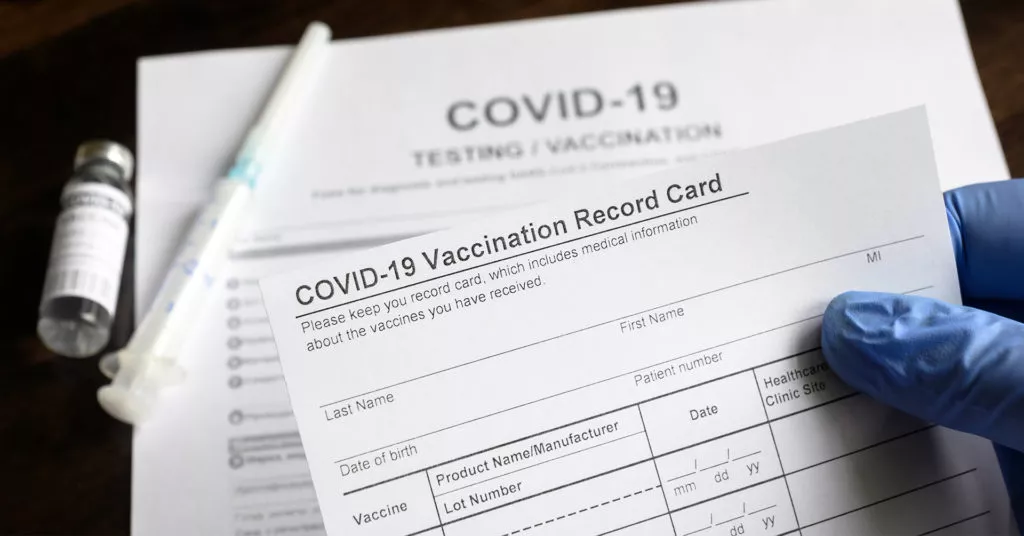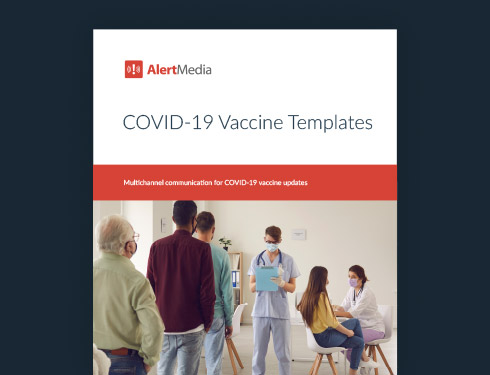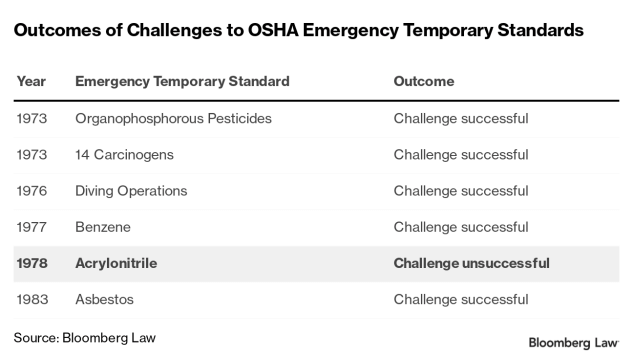
The Latest on OSHA’s ETS for COVID-19 Vaccines: What Businesses Need to Know
On November 4, 2021, OSHA issued its Emergency Temporary Standard (ETS) requiring employers with 100 or more employees to mandate COVID-19 vaccinations or weekly testing.
In this article, we’ll discuss recent developments, legal challenges, and what businesses need to know ahead of potential changes in 2022.

Update 2
On Thursday, January 13, 2022 the U.S. Supreme Court ruled in a split decision that OSHA lacks the authority to impose a vaccine-or-mandate requirement, effectively rendering the requirement—which would have impacted thousands of businesses and more than 80 million employees—no longer valid.
In a separate ruling, the Court opted not to stay a mandate requiring all health care workers at federally funded facilities to receive their first shot or submit an vaccine exemption request no later than January 27.
Update 1
On Friday, December 17, 2021, the U.S. Court of Appeals for the Sixth Circuit lifted the stay of the OSHA ETS pertaining to COVID-19 vaccination and testing requirements for employers with 100 or more employees. Shortly after, OSHA announced employers will have until January 10, 2022 to comply with all non-testing requirements and until February 9, 2022 to fully comply with the ETS.
Since early November, employers have eagerly awaited news on a pending court case involving the Occupational Safety and Health Administration’s (OSHA) Emergency Temporary Standard, which represents the most significant attempt by the federal government to increase COVID-19 vaccination rates and address lingering workplace safety concerns caused by the pandemic.
As proposed in the Federal Register, OSHA’s COVID-19 Vaccination and Testing ETS would require large private employers (those with 100 or more employees) to develop, implement, and enforce a mandatory COVID-19 vaccination policy or a policy that requires unvaccinated employees to undergo regular, weekly COVID-19 testing, in addition to wearing a face covering at work.
Nearly as soon as OSHA introduced the ETS, 26 states filed suit in the U.S. Court of Appeals to challenge the rule. Soon after, a panel from the Fifth Circuit Court of Appeals granted a nationwide stay—effectively halting the agency’s enforcement of the ETS. Employers were left with little-to-no clarity as to whether they should begin preparing for the new requirements.
In this post, we’ll discuss the current legal standing of the COVID-19 emergency temporary standard, outline what employers need to know about potential requirements, and answer some of the most common questions about OSHA’s efforts to combat the spread of the coronavirus in the workplace.
What Is the OSHA ETS?
OSHA standards are rules that define the methods employers must use to protect employees from hazards in the workplace. These rules also relate to OSHA’s General Duty Clause, which states employers must provide “a place of employment…free from recognized hazards that are causing or are likely to cause death or serious physical harm.”
In the OSH Act of 1970, which effectively established OSHA, Congress gave the agency the authority to issue an “emergency temporary standard.” Unlike a normal standard—which is usually developed methodically over an extended period with input from multiple parties—an ETS is meant only for special circumstances when time is of the essence.
Under certain limited conditions, OSHA is authorized to set emergency temporary standards that take effect immediately and stay in effect until superseded by a permanent standard. OSHA must determine that workers are in grave danger due to exposure to harmful substances or to hazards and that an emergency standard is needed to protect them. Then, OSHA publishes the emergency temporary standard in the Federal Register, where it also serves as a proposed permanent standard. It is then subject to the usual procedure for adopting a permanent standard except that a final ruling should be made within six months.
In a webinar explaining the COVID-19 ETS, the U.S. Department of Labor stated the standard’s purpose as follows:
- Establish minimum vaccination, vaccination verification, face covering, and testing requirements to address [the] grave danger of COVID-19 in the workplace
- Preempt state and local laws that interfere with the employer’s authority to require vaccination, face coverings, or testing
Recent Vaccination Policies
OSHA’s COVID-19 Emergency Temporary Standard is only the latest in several policies designed to reduce the spread of the novel coronavirus among working Americans, specifically through increasing vaccination rates at the largest public and private institutions.
Federal employees
On September 9, 2021, nearly two full months prior to OSHA issuing its COVID-19 ETS, the Biden administration announced an executive order stating it would take steps to get more Americans vaccinated and turn the tide on COVID-19. “The executive order stated that all federal agencies must implement, to the extent consistent with applicable law, a program to require COVID-19 vaccination for all of its Federal employees, with exceptions only as required by law.” According to estimates from the Office of Personnel Management, the federal workforce is composed of more than 2.1 million employees and federal contractors.
Health care providers
On November 4, 2021, the administration’s Centers for Medicare & Medicaid Services (CMS) announced similar requirements for licensed health care providers that participate in the Medicare and Medicaid programs, covering approximately 76,000 health care facilities and 17 million health care workers.
Explaining the policy, CMS Administrator Chiquita Brooks-LaSure said: “Today’s action addresses the risk of unvaccinated health care staff to patient safety and provides stability and uniformity across the nation’s health care system to strengthen the health of people and the providers who care for them.”
In support of the policies, the White House released a report detailing the efficacy of vaccination requirements, which outlined several key arguments:
- Higher vaccination rates: An analysis of organizations spanning multiple industries found employee vaccination rates increased by more than 20 percent after instituting vaccine requirements.
- Increased labor force participation: The report cites an analysis by Goldman Sachs which found that as many 5 million American workers have left the workforce during the pandemic, many of whom did so after contracting COVID-19 or due to a need to care for someone in their household. This report contends that increased vaccination rates—and lower COVID-19 case volumes—could allow a significant portion of these individuals to return to work.
OSHA ETS: FAQs
Given the breadth of the COVID-19 ETS, employers understandably have questions about what is required of them and by when. Fortunately, OSHA has published an extensive FAQ to clarify specifics. Below, we’ll cover some of the most common questions.
What does the OSHA COVID-19 ETS require?
If upheld by the courts, the ETS stipulates employers must comply with the following requirements:
- Vaccination status: Employers must determine the vaccination status of covered employees and obtain proof of vaccination.
- Vaccination policy: Employers must implement a COVID-19 vaccination policy that either mandates vaccination for all employees (with limited exceptions) or one that provides an option for weekly testing and mandatory face coverings.
- Vaccination information & resources: Employers must provide relevant information and resources to employees concerning vaccine benefits, the penalties for false reports, whistleblower protections, etc.
- Employer-paid leave: Employers must provide paid time off for employees to get vaccinated and recover from any side effects after receiving the vaccine.
- Vaccination testing: Employers who opt to offer a testing option to employees must implement a weekly testing schedule and ensure unvaccinated employees wear face coverings while at work.
- Positive test notice: Employers must require employees to give notice if they test positive for COVID-19 and remove workers until they meet specific criteria to return.
- Records and reporting: Employers must maintain records and report any work-related COVID-19 fatalities or hospitalizations.
Which employees qualify in determining whether a business meets the 100-employee threshold?
All full-time and part-time employees, regardless of employee’s vaccination status or location, count towards the 100-employee threshold as determined by the ETS. This includes fully remote employees as well as temp/seasonal employees if employed directly by the business. Contractors and other workers employed through a third party (e.g., staffing agencies, etc.) count towards the 100-employee threshold for those entities.
Is the ETS a vaccine mandate?
Technically, no. The ETS allows employers to create a policy requiring all employees to be vaccinated or one that allows unvaccinated workers to undergo weekly COVID-19 testing.
Can employers’ policies require additional measures beyond those covered in the ETS?
Yes. The ETS establishes minimum standards, but it does not preclude employers from enacting additional protective measures (e.g., requiring additional PPE, health screenings, etc.)
How should the vaccination policy be shared with employees?
According to OSHA, the vaccination policy should be made “readily accessible” and shared with employees using the employer’s normal methods of distributing information. (An emergency notification system, such as AlertMedia, is a great, convenient way to both disseminate this information and ensure you have records of when, and to whom, it was sent.)
Do employees still need to wear face coverings/masks?
Yes, if they are unvaccinated. The ETS states that employers must ensure that unvaccinated workers wear “a face covering when indoors or when occupying a vehicle with another person for work purposes, except in certain limited circumstances.”
Additionally, the rule states that employers must not prevent any employee, regardless of vaccination status, from voluntarily wearing a face covering unless it creates a serious workplace hazard (e.g., interfering with the safe operation of equipment).
Legal Debate & Challenges
While OSHA pushes forward in preparation to adopt the COVID-19 ETS in early 2022, a growing number of legal experts wonder if it will ever go into effect.
OSHA’s original guidelines stated employers had until December 6, 2021 to establish a vaccination policy, and until January 4, 2022, to ensure unvaccinated employees are tested for COVID-19 at least once per week. However, on November 12, 2021, the U.S. Circuit Court of Appeals granted a stay, effectively halting OSHA’s plans and barring the agency from both enforcing the ETS or taking steps to enforce it. It is still unclear when the new rules will be enforced, if at all.
There is a historic precedent for the speculation that this ETS will not be adopted. In OSHA’s 50-year history, the agency has issued only nine emergency temporary standards. Of these, six were challenged in the courts, and only one ultimately went into effect.

(source: Bloomberg Law)
How AlertMedia Can Help
While the fate of the most recent OSHA ETS remains unclear, employers should still familiarize themselves with its requirements and assess their current vaccination policies to determine what changes, if any, are necessary should the courts uphold the rule.
Whether communicating with your people about a workplace vaccination policy or any other time-sensitive topic, it’s also critical that your team is informed and on the same page. With AlertMedia’s emergency communication software, you can easily send and confirm receipt of time-sensitive information to keep employees up-to-date. Real-time, two-way communication features like surveys and Event Pages are also a great way to conduct wellness checks, provide updates on testing procedures, and otherwise ensure your people know what to expect before coming to work. To learn more, schedule a demo today.



![Navigating a Safe and Stable Return to the Workplace [Webinar Recap]](https://www.alertmedia.com/wp-content/uploads/2021/05/Blog-BackToWork-Webinar-v1.jpg)
